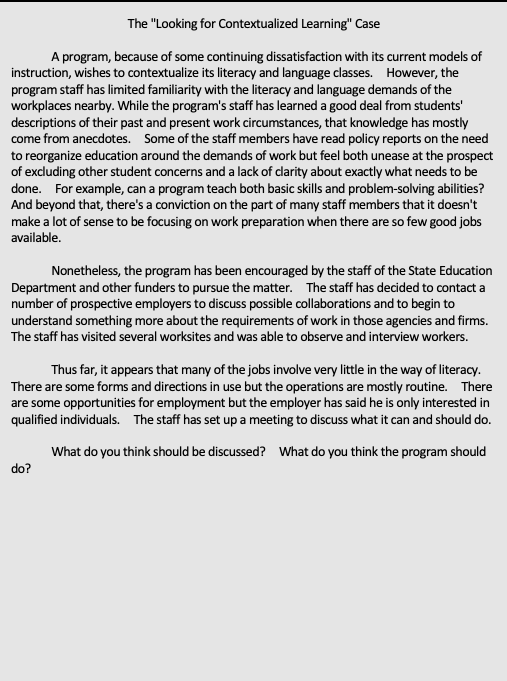On March 4th, The New York Times published a very distressing article on remediation at CUNY—it was distressing because the main concerns of the article were the financial and intellectual burden of students needing remediation, especially those needing a great deal of remediation, on the University. It is not completely clear if the thrust of the article represents what might be considered an official CUNY view or, instead, the slant adopted by the reporter. In either case, I’d like to offer another take on the matter.
CUNY has been offering remedial/developmental courses (in reading, writing and math) for more than forty years and one of the most startling facts is that, as a system, CUNY has not gotten very good at it. I emphasize the “system” because many individual faculty members and departments have worked hard at the development of more effective approaches but their efforts have not lead to the kinds of fundamental institutional changes that are needed.
Let me highlight a number of the key problems with the predominant approaches:
- the placement processes do not seem to do a consistently good job in placing students in or out of remedial sequences; the processes usually do not provide any diagnostic information that would enable teachers and students to develop thoughtful understandings of what students know and understand as well as what they don’t know and misunderstand;
- there is frequently an unrealistic expectation that students will be able to significantly enhance their skills and knowledge through participation in relatively limited periods of instruction—students in most developmental courses only attend class for between three and six hours a week;
- students are usually assigned to separate classes in reading, writing and math although it is evident that almost all students would benefit from an integrated approach wherein improvements in reading would lead to improvements in writing (and vice versa) and where improvements in literacy skills would make math learning more effective;
- many developmental courses are designed on a model which assumes that students need to focus on the “basic” skills and don’t necessarily connect those skills to meaningful content;
- the academic program of students who enroll for full-time study in order to qualify for financial aid frequently consists of an ad-hoc mix of credit and non-credit courses that does not provide a solid foundation for beginning college;
- many students who pass out of the developmental courses discover that they’re not really ready for their first credit courses.
It’s curious that the lament about remediation appears just as the University has embarked on a number of projects intended to transform the actual practice of remedial instruction. While the article alludes somewhat vaguely to a new immersion program (it’s been called the College Transitions Initiative), it doesn’t mention that the core of that effort is a radical redesign of what might be considered remediation as usual. Nor does the article mention CUNY’s new community college which will break even more sharply from past practices. In both cases, the kinds of changes being introduced are ones that will have valuable lessons not just for remedial courses but for the credit courses that the article suggests are somehow being neglected because of a preoccupation with remediation.
As the article acknowledged, most students who are deemed in need of remediation don’t succeed in their remedial courses. This is especially true for those who are deemed to be in the greatest need. And, as a result, relatively few earn as associate degree—although it’s very important to note that some colleges do much better than others and better than the system-wide averages. The top-performing community college exceeds the system average of six-year graduation rates by almost ten percentage points and exceeds the lowest-performing college by almost fifteen points. For details on graduation rates at individual colleges, go to CUNY’s Office of Institutional Research and Assessment at: http://owl.cuny.edu:7778/portal/page/portal/oira/CURRENT_CUNY_DATA_BOOK_RET_GRAD_INSTITU. Those discrepancies suggest that what colleges do and don’t do matter.
According to the article, about three-quarters (or just over 13,000) of the 17,500 freshmen at the community colleges needed remedial instruction in at least one of three areas and one-quarter (about 4400) needed it in all three.
The article points out the cost of remediation–$33 million a year. That’s a lot of money but it’s not self-evident that it’s too much. How much money is it in comparison to the whole CUNY budget for community colleges? How much is it in comparison to the amounts spent on non-remedial students? And how much money is it in comparison to the tuition paid by students needing remediation?
- Really precise budget numbers are hard to come by. CUNY’s budget is primarily composed of state funding, city funding and tuition. So far as I can tell, CUNY’s 2010-2011 community college budget was about 671 million dollars—of which just over 241 million dollars came from tuition. The cost of remediation therefore appears to be about five percent of the overall community college budget.
- In Fall 2009, the last semester for which I was able to locate data, the community colleges enrolled just under 89,000 students—of whom about 60% attended full-time. If we assume that the 2010-2011total is at least that high, it would mean that the 13,000 freshmen enrolled in remedial courses represent about fifteen percent of the total enrollment at the community colleges. Fifteen percent of the total community college budget is about $100 million. The University does incur other costs, beyond remediation, for those students since full-time students enrolled in remedial courses are not only taking remedial classes; they are simultaneously enrolled in other credit-bearing courses in order to qualify for financial aid and, hopefully, to begin accumulating credits towards their degrees. But it seems likely that this amount would not come up to $67 million—the difference between $100 million and $33 million. [1]
- Tuition for full-time students at the community colleges is currently $1650 a semester or $3300 a year (probably mostly covered through Pell Grants and TAP). Part-timers pay on a cost-per-credit and it’s hard to know what their average tuition payments might be. However, the overwhelming majority of new freshmen attend full-time (several years ago, the rate was 87%). So I’ll leave out the part-timers. How much tuition do the full-time remedial students pay? Let’s round it off a bit–85% x 13,000 x $3300 = $37 million—which is just about fifteen percent of the total tuition component of the budget.
What is clear is that the money being spent on remediation is not being spent wisely enough. More effective approaches might well require the investment of more funding but it would, hopefully, lead to far better long-term outcomes for students and therefore would be more than worth the money.
[1] Not all remedial courses are taken by new freshmen; indeed, some students take remedial courses for multiple semesters—often enough taking a course again after they have failed it. If the $33 million is the total cost of remediation, then the freshmen are having even less spent on them




Leave a Reply